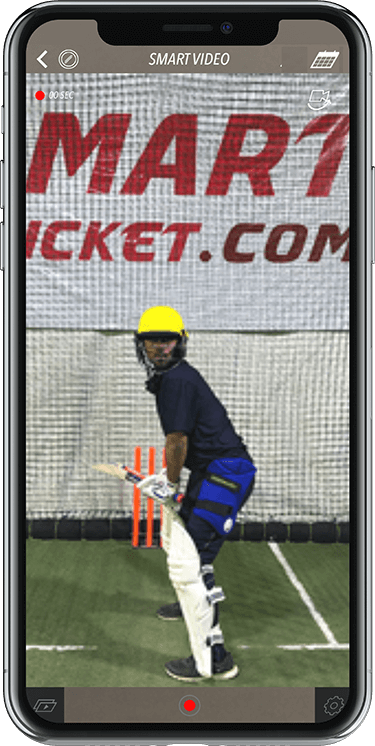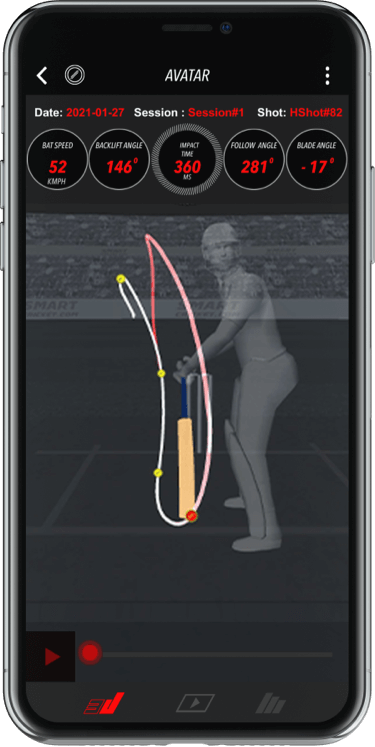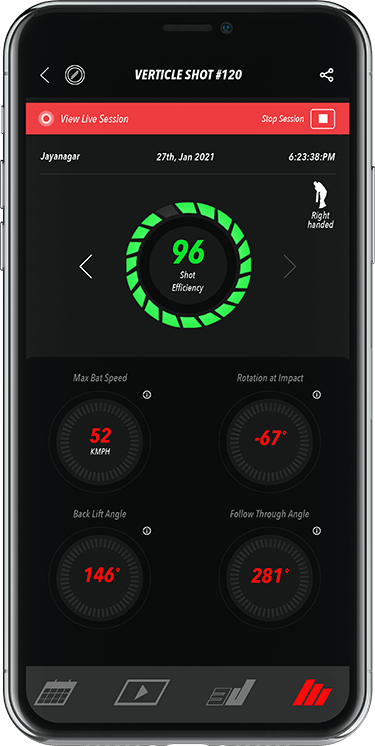Scroll for more
FEATURES
BatSense provides three crucial features prominent features. They are namely,
Smart Video
This feature records your shots when they are played.
Auto-trim feature means the video captures only the few seconds before and after the shot is played including the shot. Unnecessary events in between like waiting time between each shot is cut out automatically by the app.
Videos can also be classified according to stroke type, such as Cover Drive, Straight Drive, Pull, etc.
Compare Shot feature allows any two strokes be compared. Shots from multiple sessions recorded in one single day are comparable.

3D Avatar
3D depiction of each shot that is played in a session. This feature enables the 360-degree analysis of a shot and creates an animation depicting the bat trajectory of the entire stroke.
It also displays key parameters associated with the shot such as Bat Speed, Back Lift Angle, Impact Time, Follow Through Angle, and Blade Angle.

Batting Parameters
11 Parameters are displayed for every shot played. Important elements like Bat Speed (Average, Maximum and Speed at Impact) Back Lift Angle, Follow-Through Angle, Bat Start Angle, Blade Angle among others are captured and displayed to the user.
Helps to understand the batting tendencies and preferences of a player and accommodates technique correction based on the insights provided to players and coaches.

Batting Parameters
Explained by Mark Garaway
Shot Efficiency
Shot efficiency is the correlation between Max Bat Speed achieved while playing a shot and the Speed at Impact (bat speed during the point at which it makes contact with the bat). There is a direct correlation between the two, meaning, when both elements are in equal degrees, the efficiency is 100. This element is important to understand the timing efficiency and how it can be greatly improved by helping lessen the gap between the two corresponding elements.
Eg: For a shot, Max Bat Speed achieved = 55. And the Speed at Impact = 50. Then the Shot Efficiency is 91. Whereas when Max Bat Speed achieved = 55 and the Speed at Impact is also 55, then the Shot Efficiency is 100.
Mark Says: Hit the ball later. If you hit the ball during the latter stage the downswing of your bat (later) then you will carry high bat speed into the contact point. If you hit the ball early then your bat will be in the follow through zone. Follow through is when we are decelerating the bat. Players who play the ball early are generally decelerating their bat into the contact point
Max Bat Speed
The maximum speed of the bat achieved at any point during the bat swing, starting from the Back Lift to the Follow Through. There are different speeds that a bat goes through during a swing and this parameter tells you the maximum speed generated at a particular point in time. This element is important to understand the upper and lower ceiling of potency and power of a batsman to generate with an average bat swing.
Mark Says: “Fast hands” come as a result of the way that the batter has transferred energy through the body from the legs, through the torso, across the shoulders, through the arms and then into the hands. The better we use our bodies, the “faster the hands” - think of the bat being the tip of the whip and the body being the handle of the whip.
Rotation At Impact
Vertical Shots
The angle of rotation at the point of impact if the bat face is opened (off side) are negative angles. If the bat face is closed (on side) during impact are positive angles. Bowler end stumps is considered as zero.
Horizontal Shots
The angle of rotation around the handle of the bat at the point of impact with the ball when the player is hitting the shot. This is the wrist motion which determines if the bat face was open or closed and to what degree at the time of impact with the ball. This angle helps determine if the shot was played on air or on ground.
The angle of rotation around the handle of the bat at the point of impact with the ball. This is the wrist motion which determines if the bat face is turning which way, whether it is open or closed and to what degree at the time of impact with the ball. This element is crucial to understand the wrist tendencies and the extent to which a player is using his wrist. The angle will be shown in negative numbers if played towards the off-side and positive angle if played on-side.
Mark Says: While playing a pull shot, a player has problems keeping the ball grounded, which means he isn't rotating his wrists enough. This can be seen with Rotation at Impact Angles recorded. Now, taking note of this, the coach can suggest improvement drills to the player and then record his shots, with the subsequent Rotation at Impact Angles clearly showing whether or not the player is using his wrists more to keep the ball grounded.
Backlift Angle
Angle of the back lift with respect to the bat being held vertically.
Back lift angle helps to understand whether the batsman has got a short or high-back lift. Measured in degrees, the higher the back lift, the more is the degree associated with it. Back lift angle is important through the relation it maintains with the speed of the bat and the time that it helps to taken between lifting the bat and the ball impacting the bat. No specified back lift is suitable for all, different players have different back lifts and that is left up to the players and coach to infer and decide based on their experience.
Mark Says: Batters tend to have a preference for a higher or lower back lift - do you know what yours is? Kevin Pietersen generally had a lower backlift, around 125 degrees whereas Brian Lara had a backlift in excess of 170 degrees for most of his shots. Both batters hit the ball very hard, just in different ways. Modern day coaches often encourage batters to extend their back lift angle by a few degrees in order to create a more extensive distance for the bat to move before the contact point occurs. This extra range of motion can increase the bats speed on its journey to the ball. BatSense allows each batter to adjust their back lift angle through objective experimentation to find their “sweet spot”.
Follow Through Angle
Angle of the follow through with respect to the bat being held vertically. This is measured from the time of impact onwards until the bat finishes its follow-through. Follow-through angle is very important to hold balance after playing a shot. Coaches insist on having a complete follow through after playing a shot, especially the drives. Follow-through angles depict in degree the amount of momentum generated after impacting the ball. It has a strong relation with the distance the ball travels and these degrees help to understand the average follow-through a batsman possesses.
Mark Says: Most top quality players have adaptable follow through angles and display these throughout an innings. Straight drives along the ground past pace bowlers tend to have shorter follow through angles whereas, more typically, batters display fuller follow through angles when driving the ball through the covers, square of the wicket or when hitting the ball straight over a spinners head. BatSense provides feedback on each and every follow through building awareness and understanding with each shot. Batters can then be more in control of their shots and therefore, their game. The key thing is to recognize the opportunity and adapt your follow through option accordingly.
Impact Time
Time elapsed (in milliseconds) from the Back-Lift point to the point of impact. This helps to understand the amount of time the batsman is using to play a shot from the time he lifts the bat. This is the reaction time for the batsman and shows how well he adjusts to the pace of the ball heading towards him.
Mark Says: The batsman playing against a spinner as compared to a fast bowler will have more time to react to the ball and vice versa. This can be studied and further analysed how much is the difference between the two bowlers using the impact time of the batsman.
Speed At Impact
The speed of the bat (in kmph) at the point of impact with the ball. The bat starts from point A and finishes at point B, therefore has different speeds at different points. And the ball impacts the bat somewhere during the course of its swing from A to B. The speed of the bat when the ball impacts it, is called Speed at Impact and this is crucial for the relationship it possesses with Max Speed Bat parameter and how it influences the Average Shot efficiency parameter.
Mark Says: Player with a very high Max Bat Speed parameter can still struggle to get the ball to go far as he might be playing the shot too early or too late. This can be accurately circled in on with the help of Speed at Impact data for each shot.
Avg Speed
The average speed of the bat (in kmph) throughout the shot, from back lift to follow through. The bat travels from point A (back-lift) to point B (impact with ball). Speed generated varies at different points and this variation is calculated for shows the Average Speed of the Bat.
Mark Says: if we are specific about which format and situation we are practicing for then our average bat speed should reflect accordingly. If we are practicing to be able to hit the ball into the stands then our average bat speed would be high. If we are practicing to learn how to manipulate the ball against spin then we are likely to see lower average bat speeds. So, set your session intention and check to see how your average bat speed correlates with that intention
Bat Start Angle
Bat orientation with respect to the player at the time of back lift. Provides information as to where the bat is pointing before the shot begins. This parameter shows whether the bat is facing 1st or 2nd slip. The measurement is shown in Degrees, lesser degrees meaning the bat is facing more towards the first slip/wicketkeeper and while larger degrees mean the bat is facing squarer towards 2nd slip onwards and increasing.
Bat orientation with respect to the player at the time of back lift. Provides information as to where the bat is pointing before the shot begins. This parameter shows whether the bat is facing 1st or 2nd slip. The measurement is shown in Degrees, lesser degrees meaning the bat is facing more towards the first slip/wicketkeeper and while larger degrees mean the bat is facing squarer towards 2nd slip onwards and increasing.
Mark Says: a consistent technical flaw is when the bat disappears behind the batter's body (-25degrees on the image). This results in the batter having to pull the bat around the body to then access the ball. The bath path is compromised, and control & contact are negatively impacted.
Most of the best players in the world will have their top of Batswing visible to the bowler and the incoming ball. Some, (Hashim Alma) would have a larger positive degree Bat Start Angle and most would have their range between +10 and higher
Blade Angle
Angle of rotation around the handle of the bat when a player is starting the shot. This is calculated as zero degrees when facing parallel with the ground while being held by the batsman in normal back lift. Any tilt which means the bat face is open or closed will be displayed with negative or positive angles depending on the batsman.
Mark Says: The angle of the blade at the peak of the Back Lift often provides an early indication of the way that the batter prefers to strike the ball. An predominantly onside player is likely to have a positive blade angle (closed) whereas a predominantly offsided player is likely to display a more open bat face at the top of the Backlift (circa -15 deg). Again, understanding your blade angle can either confirm what you thought you did all along or, as on a number of occasions in recent history with players who I work work with, helps identify a relatively easy “blade angle fix” which would have gone un-noticed without BatSense technology.
Impact Angle
The angle that the bat makes with the ground vertically at the time of impact with the ball. This angle helps to measure whether the ball is hit on the ground or in the air. This element is crucial in understanding a batsman's tendency to play either on the ground or in the air. The angle is measured in degree and is shown negative if played in the air and positive in facing towards the ground at the time of impact.
Mark Says: Impact Angle (Launch Angle): we know that a 40-42 degree launch angle is most likely range to enable a batter to hit the ball for 6. It provides the largest margin for error and is the angle range associated with the biggest sixes on vertical batted shots. We also know that a negative degree impact angle enables the ball to be hit into the ground. I often tell players “to keep the ball along the ground or hit it out of the ground....that is attacking batting, nothing in between”. BatSense enables the batter to track their impact angle metrics against that simple batting fundamental.
BENEFITS
Player Benefits
- Gain Factual Insights into your batting
- Study, Analyse and Correct your technique
- Instant Feedback and Connectivity with Coaches
- Customized Training Programmes
- Session, Weekly and Monthly Synopsis of Performance
- Smart Video, 3D View and Wagon Wheel Access
- In-App Calendar Storage and Data Repository
Coach Benefits
- Gain Factual Insights into your players batting
- Study, Analyse and Correct your players technique
- Instant Feedback and Connectivity with your players
- Customized Training Programmes by Set Goals feature
- Session, Weekly and Monthly Synopsis of players Performance
- Smart Video, 3D View and Wagon Wheel Access of all sessions of your players.
- Access to players Calendar to check players Performance.



